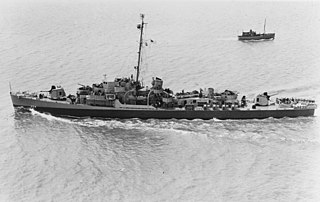
USS Rudderow (DE-224) was the lead ship of her class of destroyer escorts, in service with the United States Navy from 1944 to 1947. After spending decades in reserve, she was sold for scrap in 1970.

USS MacLeish (DD-220/AG-87) was a Clemson-class destroyer in the United States Navy during World War II. She was named for Lieutenant Kenneth MacLeish.
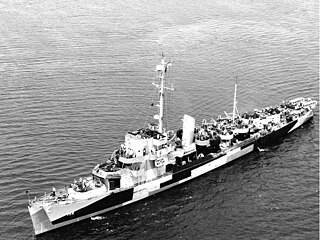
USS Peterson (DE–152) was an Edsall class destroyer escort, the first United States Navy ship so named. This ship was named for Chief Water Tender Oscar V. Peterson (1899–1942), who was awarded the Medal of Honor posthumously for his actions during the Battle of the Coral Sea.
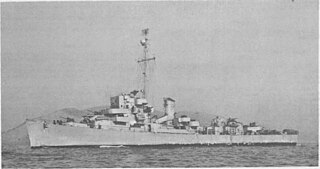
USS Gendreau (DE-639) was a Buckley-class destroyer escort in the United States Navy. She was commissioned on 17 March 1944 and decommissioned on 13 March 1948. She served throughout the Pacific during World War II.

USS Eberle (DD-430) was a Gleaves-class destroyer of the United States Navy. The ship is named for Rear Admiral Edward Walter Eberle, who commanded the Atlantic and Pacific Fleets and was Chief of Naval Operations from 1923 to 1927. The destroyer entered service in 1940 and spent the majority of her career in the Atlantic Ocean. Placed in reserve following the war, the ship was transferred to the Hellenic Navy in 1951. Renamed Niki, the destroyer remained in service until 1972 when she was scrapped.

USS Finch (DE-328) was an Edsall-class destroyer escort in the service of the United States Navy from 1943 to 1946 and from 1956 to 1969. From 1951 to 1954, she was loaned to the United States Coast Guard where she served as USCGC Finch (WDE-428). She was scrapped in 1974.
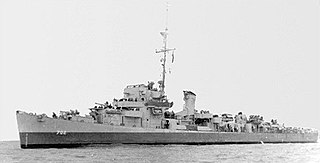
USS Earl V. Johnson (DE-702) was a Buckley-class destroyer escort in service with the United States Navy from 1944 to 1946. She was scrapped in 1968.

USS Hissem (DE-400/DER-400) was an Edsall class destroyer escort of the United States Navy. Hissem was constructed in 1943 as DE-400. In 1955, the vessel was equipped with modern radars, and the designation was changed to DER-400. The special purpose of DER ships was the detection of aircraft. Their chief role was to extend the DEW line out into the N. Atlantic and the N. Pacific oceans.

USS Frybarger (DE/DEC-705) was a Buckley-class destroyer escort in service with the United States Navy from 1944 to 1947 and from 1950 to 1957. She was scrapped in 1973.

USS Hayter (DE-212/APD-80) was a Buckley-class destroyer escort in service with the United States Navy from 1943 to 1946. In 1967, she was transferred to South Korea where she served as ROKS Jonnam until 1986.

USS Enright (DE-216/APD-66) was a Buckley-class destroyer escort in serivce with the United States Navy from 1943 to 1946. In 1967, she was transferred to Ecuador where she served until she was scrapped in 1989.
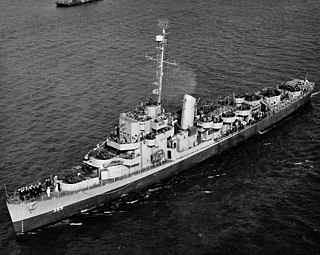
USS Stockdale (DE–399) was an Edsall-class destroyer escort in service with the United States Navy from 1943 to 1947. She was sunk as a target in 1974..

USS Daniel (DE-335) was an Edsall-class destroyer escort in service with the United States Navy from 1944 to 1946. She was scrapped in 1974.
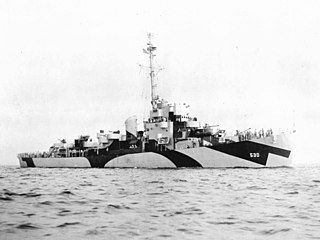
USS John M. Bermingham (DE-530) was an Evarts class destroyer escort constructed for the United States Navy during World War II. She was sent off into North Atlantic Ocean waters to protect convoys and other ships from German submarines and fighter aircraft. She performed escort and antisubmarine operations in battle areas before being retired and subsequently scrapped.
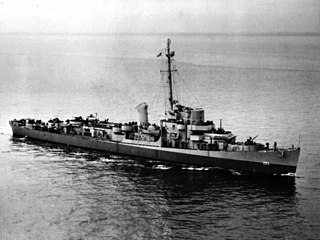
USS Carroll (DE-171) was a Cannon-class destroyer escort in service with the United States Navy from 1943 to 1946. She was sold for scrap in 1966.

USS Rinehart (DE-196) was a Cannon-class destroyer escort built for the United States Navy during World War II. She served in the Atlantic Ocean and Pacific Ocean and provided escort service against submarine and air attack for Navy vessels and convoys. The ship entered the reserves after the end of the war, and in 1950 was transferred to the Royal Netherlands Navy, where she served under the name De Bitter until 1967. She was sold for scrap in 1968.

USS Cates (DE-763) was a Cannon-class destroyer escort built for the United States Navy during World War II. She served in the Atlantic Ocean and the Pacific Ocean and provided escort service against submarine and air attack for Navy vessels and convoys.
USS Clamour (AM-160) was an Admirable-class minesweeper built for the U.S. Navy during World War II. She was built to clear minefields in offshore waters, and served the Navy in the Pacific Ocean.

USS Hollis (DE-794/APD-86) was a Buckley-class destroyer escort in service with the United States Navy from 1944 to 1947 and from 1951 to 1956. She was scrapped in 1975.

USS Eugene E. Elmore (DE-686) was a Rudderow-class destroyer escort in the United States Navy during World War II.



















